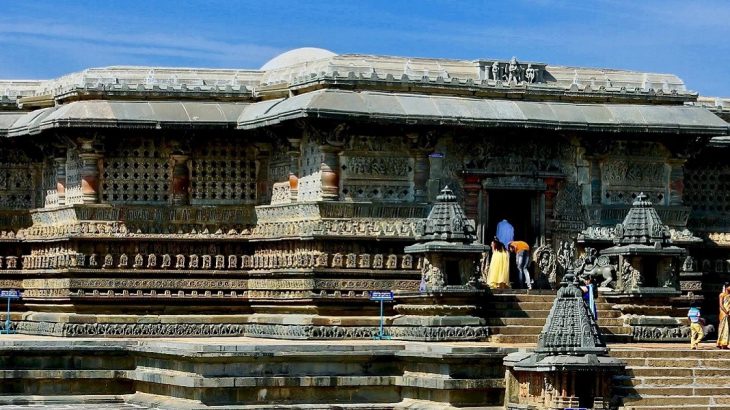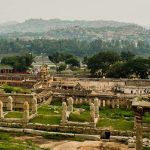UNESCO recognized the ancient Hoysala temples in Karnataka as ‘World Heritage Sites’ on 18th September 2023 during the 45th session of the World Heritage Committee currently underway in Riyadh, Saudi Arabia. The sacred ensemble of the Hoysalas consists of three temples from the 12-13th century CE, namely the Chennakeshava Temple in Belur, the Hoysaleshwara Temple in Halebidu, and the Keshava Temple of Somnathpura, among the top places to visit as part of Mysore tour. These temples have been on the UNESCO tentative list since 2014. In 2019, the Bengaluru chapter of the Indian National Trust for Culture and Heritage (INTACH) asked by the Karnataka government’s Department of Archeology, Museums, and Heritage to work on the nomination dossier. Their efforts finally bore fruit and the Hoysala Temples were officially confirmed as a World Heritage Site, India’s 42nd on the UNESCO list. These temples are best known for intricate soapstone carvings, star-shaped shrines, roomy passages, and idols that exhibit sculptural genius. Here are some lesser-known facts about these marvels which provide a richer viewpoint, allowing for a more complete understanding of these magnificent temples when you visit next time as part of the Karnataka tour packages.
Confluence of Styles
The Hoysalas of Karnataka have built a lot of phenomenal structures that define the architecture during their reign from the 11th to 14th centuries. Many temples built during this era remain examples of the Hoysala architectural style, including the Chennakesava Temple at Belur, the Hoysaleswara Temple at Halebidu, and the Kesava Temple at Somanathapura, among the must-include places in Karnataka packages. These temples built by Hoysalas are an amalgamation of three distinctive temple styles prevalent in India, which include the Bhumija style of central India, the Nagara traditions of northern India, and the Dravidian style represented in Pallava and Chola temples of South India. The architects of the Hoysala temples not only demonstrated their knowledge of different temple-building traditions and forms but incorporated them differently in these three temples.
Book Here : Belur Tour Packages
A Symbol of Religious Harmony
The sacred ensemble of the Hoysalas was built at the time Jainism was prominent in the region. It thus marks a turn towards Hinduism. Though mostly dedicated to Hindu deities, these temples also honor Jain Tirthankaras. This demonstrates the peaceful religious coexistence of the time. The Chennakeshava Temple at Belur also known as the ‘modern Vaikuntha on earth’ is the largest and most elaborate of the Hoysala temples. Belur Temple is dedicated to the Hindu god Vishnu, while the Hoysaleswara Temple at Halebidu is dedicated to the Hindu god Shiva, and is among the must-visit places during the Chikmagalur tour. These temples were known for their exquisite soapstone carvings that are simply stunning. The Keshava Temple at Somnathapura is smaller than many other Hoysala temples. But, it is no less impressive than the temples at Belur and Halebidu, among the top places to visit near Bangalore.
Book Here : Halebidu Tour Packages
Star-Shaped Platform
The most amazing fact about these marvels is that these temples depart from the usual linear temple layout instead displaying a star-shaped appearance that gives aesthetic richness and more effective natural lighting. The base comprises eight rows of friezes featuring intricate carvings of elephants, lions, horses, and floral scrolls. The temple walls are adorned with beautifully carved Hindu deities, sages, birds, stylized animals, and friezes depicting the life of Hoysala kings. The outer walls feature imagery from Indian epics like Ramayana, Mahabharata, and Bhagavad Gita, along with highly ornate temple doorways. Belur is one of the best heritage places to visit near Mysore.
Soap Stone Marvels
The early Hoysala temples were made from granite and didn’t have intricate detailing just like the later temples of Belur, Halebid, and Somnathapura, among the top places to visit near Mangalore. The temple carvings were made from soapstone, a soft stone that is easier to carve. From deep fluting carving techniques to decorative motifs, almost every surface of these temples is embellished. Mantapa is often preceded by a grand entryway with an ornamented overhead arch. Inside, the ceiling is supported by several pillars that form bays, thereby elevating the architectural appeal of the prayer hall. Another feature of the Hoysala temples is the Vimana- the most sacred shrine which houses the image of the presiding deity. On the outside, the Vimana is decorated with a star or square-shaped dome. Unfortunately, in the 14th century, the armies of Alauddin Khilji and Muhammad Tughlak invaded the Hoysalas, ruined the temples, and looted a vast amount of wealth and riches.
A Celebration of Uniqueness
This Hoysala temple at Belur was built by King Vishnuvardhana to commemorate his victory over the Cholas in 1116 CE. The temple features numerous pillars that are profusely decorated with carvings. While no two pillars in this temple are alike, make sure to catch a glimpse of the surreal Mohini pillar. , most popular and intrinsic in terms of art, is the Narasimha Pillar, which is covered with miniature figures all over it. It is said that the pillar has ball bearings on the top and could be rotated in its heyday. The fine details and the glistening of the soapstone with the warm light of the diyas around it totally enhance the beauty of this pillar at Belur, among the best heritage sites near Mysore.
Intricate Carvings with Minute Details
The sacred ensemble of the Hoysalas, among the top places of heritage in Karnataka, was known for their elaborate, ornamental, and delicate carvings, sculptures with complex hairstyles, clothing, and jewelry. The themes of the sculptures include animals, scenes of daily life, as well as depictions from the epics and the Puranas. The most popular among them are the madanikas or nymphs, which are said to have been modeled after the beautiful Queen Shantala, wife of King Vishnuvardhana. The most popular amongst these is the Darpan Sundari (lady with the mirror). These madanikas depict some form of dance, musical instrument, or grooming. Another popular one is a lady with the parrot and the huntress. Right above the various entrances of the temple are beautiful ornate arches with intricate details.
Book Here : Mysore Tour Packages
Female Artisans
Another lesser-known fact is that women artists also contributed to the creation of these marvels. While the names of male sculptors predominate, there are sculptures with female artisans’ insignia as well. These temples can be visited along with Chikmagalur tour packages.























